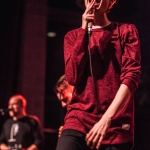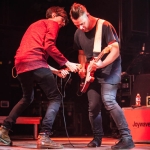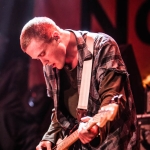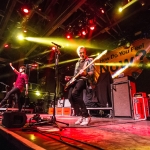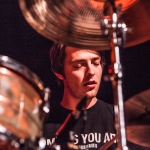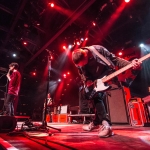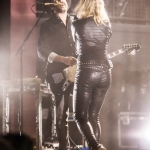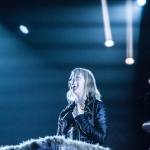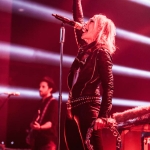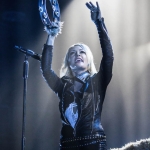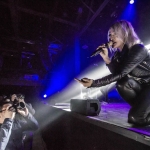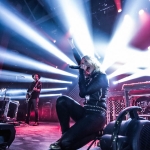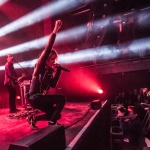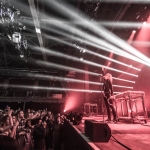
Metric | photo by Josh Pelta-Heller | hellerhound.com
Metric delivered an arena-caliber performance at The Fillmore
The arena-caliber kaleidoscopic lights-and-color show to which Metric treated a crowded room yesterday evening seemed an apt testament to how much of a rockstar Emily Haines has become over the years. Or, maybe she’s always been a rockstar. Maybe what’s really evolved is that she and her band are simply finally getting their due, along with more mainstream radio play, of regularly headlining larger venues like Fillmore Philly, on stages with some breathing room and all the production value to match.
Either way, what’s arguably always been most impressive about Haines, both in the context of Metric and also The Soft Skeleton — the album of piano music she called at a January 2007 show at the Unitarian Church “a Winter record” — is the substance behind the synth. She consistently offers her fans depth and diversity, whether lingering on Lou Reed covers, delivering Metric’s rousing radio pop, or a moody set of acoustic ballads. Perhaps it’s her poetry pedigree that lends her lyrics all of their subtle nuance, the adroit wordplay and turns of phrase, and the crafty cadences supporting her hooks and beguiling vocals.
Metric’s shows are capable of switching gears seamlessly, throttling forward toward throbbing new wave or back to intimate interludes of acoustic guitar breaks, with part of the band on break. Haines can proclaim profane in “Artificial Nocturne,” bring kids and their parents onstage for a Hey-Jude-choral-edition of “Dreams So Real,” and dive headfirst into the acerbic commentary of “Sick Muse.”
Apart from an a cappella false-start of “Combat Baby” shortly before breaking for an encore, Haines and co. leaned heavily throughout a long show on their three most recent records, in a set studded throughout with cuts from their latest LP Pagans In Vegas. Much of the music from Pagans can feel forbidding, less vulnerable, less warmly inviting than some their older material, something of a soundtrack for a darkened and disquieting dystopia. Here Haines is able to again draw the paradox, connecting throughout to her crowd anyway, and pausing toward the end to muse in meditation on music as time capsule, with a nod to fans who have followed her band since the beginning.
- Joywave | photo by Josh Pelta-Heller | hellerhound.com
- Joywave | photo by Josh Pelta-Heller | hellerhound.com
- Joywave | photo by Josh Pelta-Heller | hellerhound.com
- Joywave | photo by Josh Pelta-Heller | hellerhound.com
- Joywave | photo by Josh Pelta-Heller | hellerhound.com
- Joywave | photo by Josh Pelta-Heller | hellerhound.com
- Joywave | photo by Josh Pelta-Heller | hellerhound.com
- Joywave | photo by Josh Pelta-Heller | hellerhound.com
- Joywave | photo by Josh Pelta-Heller | hellerhound.com
- Metric | photo by Josh Pelta-Heller | hellerhound.com
- Metric | photo by Josh Pelta-Heller | hellerhound.com
- Metric | photo by Josh Pelta-Heller | hellerhound.com
- Metric | photo by Josh Pelta-Heller | hellerhound.com
- Metric | photo by Josh Pelta-Heller | hellerhound.com
- Metric | photo by Josh Pelta-Heller | hellerhound.com
- Metric | photo by Josh Pelta-Heller | hellerhound.com
- Metric | photo by Josh Pelta-Heller | hellerhound.com
- Metric | photo by Josh Pelta-Heller | hellerhound.com
- Metric | photo by Josh Pelta-Heller | hellerhound.com
- Metric | photo by Josh Pelta-Heller | hellerhound.com
- Metric | photo by Josh Pelta-Heller | hellerhound.com
- Metric | photo by Josh Pelta-Heller | hellerhound.com
- Metric | photo by Josh Pelta-Heller | hellerhound.com
- Metric | photo by Josh Pelta-Heller | hellerhound.com


